Giant Wētā Profile
The Pitaya ratio is the difference between the aesthetics of an item and what it’s like inside. If you’ve ever experienced the disappointment of dragon fruit you’ll know the pain a high Pitaya ratio can bring.
However, sometimes the ratio goes the other way. Sometimes there’s an animal so grotesque and clambering that it sends shivers down your spine, yet, if you can overcome your first impression, it turns out to be the arthropod version of a fluffy little bunny.
This is the case with the Giant wētā; a “terrible grasshopper” from New Zealand that’s the size of a ship rat and has a penchant for carrots.
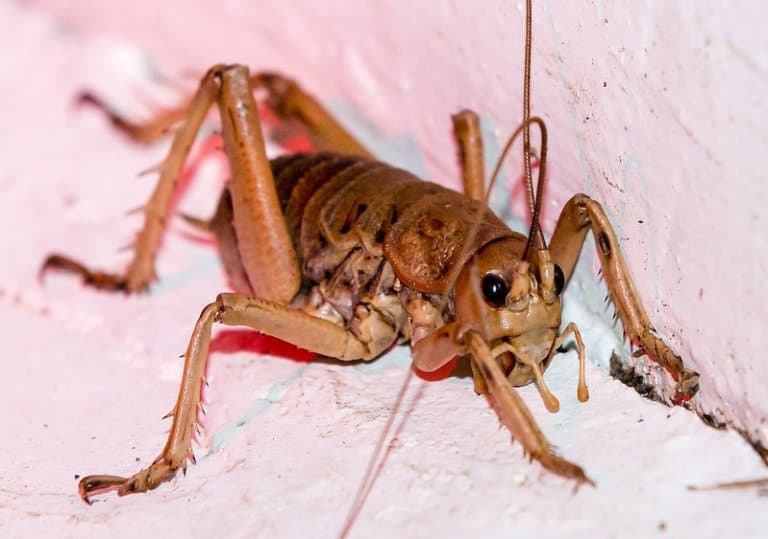
Giant Wētā Facts Overview
| Habitat: | Forest floors, burrows |
| Location: | New Zealand |
| Lifespan: | Up to 9 months in the largest species |
| Size: | 17.5cm (7inches) long |
| Weight: | 71g |
| Color: | Brown, black, reddish-brown |
| Diet: | Mostly lichens, leaves, flowers, seeds and fruit |
| Predators: | Rats, birds, tuatara, morepork |
| Top Speed: | Slow |
| No. of Species: |
11 |
| Conservation Status: |
Vulnerable to Data deficient, critically endangered in some populations |
Giant wētā are 11 species of wētā, and just one branch of about a hundred species of wētā, located exclusively in New Zealand.
Wētā are giant flightless crickets that are usually nocturnal. They’re huge because they evolved in an area without mammals, and so have occupied some of their niches instead.
They are forest floor dwellers and are mainly herbivorous and feed on forest plants and foliage.
Giant wētā can grow up to around 10cm (4 inches) in body length (excluding legs and antennae). The largest species of Giant wētā is the Little Barrier Island giant wētā, also known as the wētāpunga.
While they look scary, they’re very docile and can be handled very easily. They’re tough, too, and can handle very cold temperatures.
Unfortunately, the wētā has struggled to resist the predation of invasive mammal species like cats and rats, and now there are conservation programs in place to keep several of the species from becoming extinct.
Interesting Giant Wētā Facts
1. Terrible Grasshoppers
The giant wētā is an ugly animal, there’s no doubt about it. The genus Deinacrida Translates to “terrible grasshopper” (and shares the prefix with the word Dinosaur, meaning “terrible lizard”).
Though in the same order, this is no grasshopper. It’s an enormous cricket. But, unlike other species of wētā, these gentle giants eat primarily vegetation and are unlikely to have a go at your face.
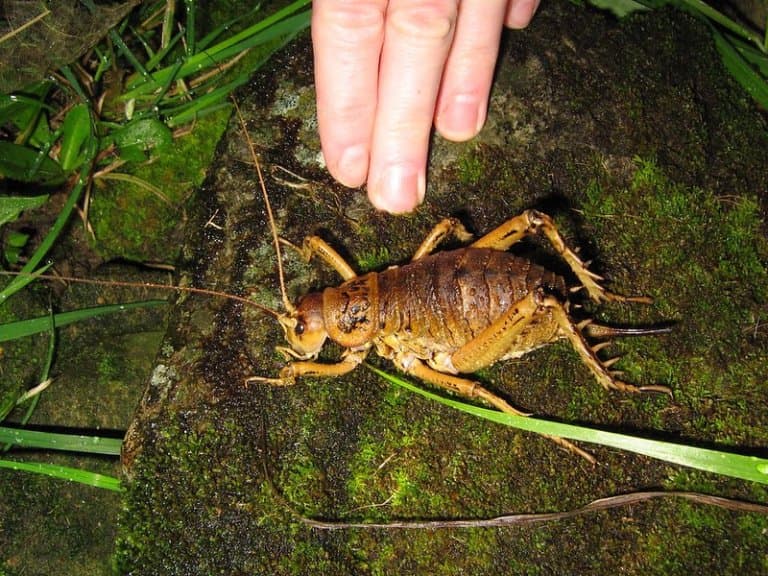
2. They can survive being frozen solid
Many species are found at high altitudes, where they commonly face sub-zero temperatures. The scree wētā can withstand temperatures as low as -10°C and will freeze solid at -5°C. 1
3. They’re one of the largest insects in the world
The Little Barrier Island giant wētā Deinacrida heteracantha, is a lanky cricket!
The largest measured had a body length of 11 cm (including the ovipositor), and a leg span of over 17.5 cm (7 in).
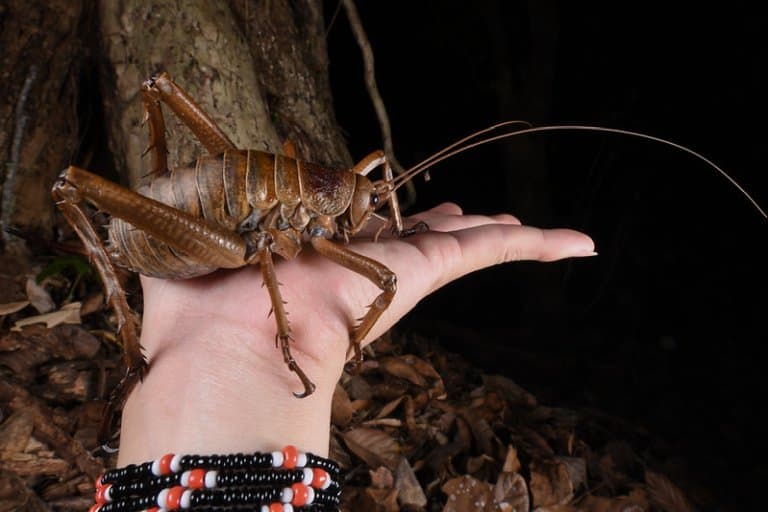
4. They have ears on their knees
Wētā ear holes are located on the front legs, just below the knee joint. 2
5. They’ve been decimated by rats
The same species is classed as vulnerable by the IUCN due to their number suffering from invasive mammal species. New Zealand has struggled with invaders on the islands for a long time; rats coming in from ships eat birds’ eggs, and domestic cats, turned feral, eat the birds themselves.
In an ecosystem that never evolved to handle mammalian predators, this is a very dangerous concept. Though even efforts to make things better can have a cascade of effects on wildlife.
Since cat numbers have been reduced, rat numbers have gone up, and one of the casualties of this boom is the Little Barrier Island wētā.
Native predators include the incredible lizard-like reptile the tuatara, and a hilariously-named bird: the morepork. 3
6. There are breeding programs in place
The Department of Conservation in NZ has been running a captive and release programme since 2008, with the aim of increasing populations to a sustainable level on a number of islands.
Spreading out the populations across multiple islands offers the species a better chance of survival, and can provide the wētā with areas of predator-free land, uncolonized by rats and cats.
By 2018, well over 4000 captive-bred giant wētā had been released on several islands. 4
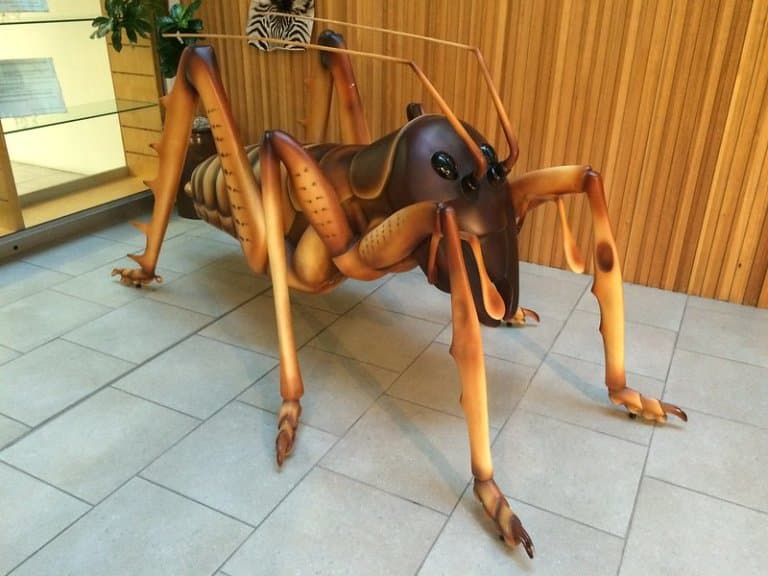
7. There’s an order of magnitude between the smallest and the largest
Some so-called giant wētās aren’t so big after all.
Mt Authur giant wētā weight 7g and is about 3 to 4cm long, and yet, even for a giant wētā, this isn’t the smallest. The Foveaux wētā gets as tiny as 2.5cm (1 inch) and weighs as little as 2g.
However, there are some real monsters, too. These species are significantly smaller than one of the largest species, Deinacrida elegans, the females of which reach over 70g, and potentially a lot more. 5
8. They might be the heaviest insect
Or, they might not. As usual, these things are difficult to ascertain with any confidence.
The heaviest wētā reliably recorded was 71g, which would put it behind some of the chunkier beetles, but there are also unconfirmed claims of it hitting twice that weight.
Sadly, there isn’t much money in going around weighing everything (or we’d probably be doing that already), so we might have to wait a little longer to find out.
9. They can’t jump
Giant wētā are so large, they just aren’t agile enough to fly or jump like a normal cricket. Some smaller wētā species are more typical, however!
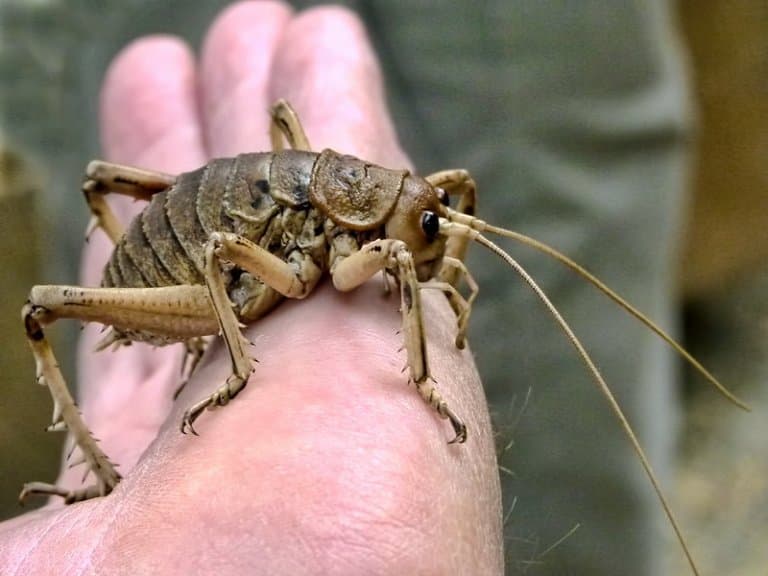
10. They don’t have lungs
Giant wētā, like other insects, does not have typical lungs, they breathe through their exoskeleton.
Holes in the weta’s shell connect to tubes that deliver oxygen to every cell in the insect’s body.
11. They love carrots
Despite their looks, giant wētās are herbivores, with the occasional exception when they might choose to take in some insect protein.
Much like crickets, they’re relatively harmless (though they can give you a little nip) and usually are quite okay with being handled.
In 2011, claims surfaced of the largest insect ever photographed. The photo was of an enormous wētā, sitting comfortably in the hand of a researcher, eating a carrot.
12. They’re significant to the ecosystem
There are no native mammals in New Zealand, other than bats. This makes the ecosystem particularly unusual and is partly what gave rise to the odd and interesting wētā in the first place.
When mammals are not in the picture, other animals take up their niches, and where mice and voles would have occupied the forest floor, in NZ, this space was left open for the wētā to exploit.
In fact, when invasive mice enter the ecosystem, they compete with the wētā for resources. This is a great example of how evolution solves problems, and how niches get filled, if not by one organism, then by another.
Giant Wētā Fact-File Summary
Scientific Classification
| Kingdom: | Animalia |
| Phylum: | Arthropoda |
| Class: | Insecta |
| Order: | Orthoptera |
| Family: | Anostostomatidae |
| Subfamily: | Deinacridinae |
| Genus: |
Deinacrida |
Fact Sources & References
- Brent J. Sinclair (1999), “Insect cold tolerance: How many kinds of frozen?“, University of Otago.
- “A giant wētā showing its ears“, Department of Conservation, New Zealand Government.
- “Giant wētā/wētāpunga“, Department of Conservation, New Zealand Government.
- “Wētā“, Department of Conservation, New Zealand Government.
- Dean Praetorius (2011), “Giant Weta, World’s Largest Insect, Photographed In New Zealand (PHOTO)“, Huffington Post.
